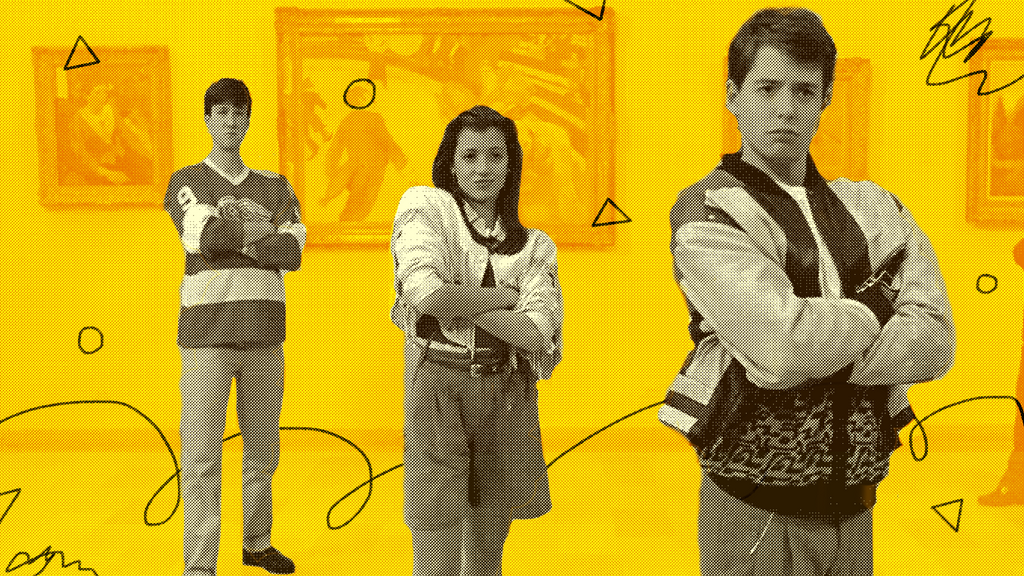Storyclock Research Log
Ferris Bueller's Day Off

This week in the Research Log, I invited filmmaker and Texan treasure Ryan Polly from Maker Table to clock one of his favorite movies, the 1986 John Hughes masterpiece FERRIS BUELLER’S DAY OFF. As usual, he watched the movie and used the Storyclock Notebook to visualize the film's structure in the form of a clock.
So here you go, Ryan. You type now.
Let's Break It Down
- Opening Image: A nice suburban house. Chicago weather report on the radio immediately establishes the setting.
- The Setup: Ferris fakes sick. His parents buy it.
- Herald: Ferris calls Cameron up to get the day started.
- Rational Approach: Cameron refuses to leave his house but eventually gives in.
- Break Into Act 2: Ferris and Cameron pick up Sloan. THE ADVENTURE BEGINS.
- B Story Begins: Rooney leaves school to catch Ferris.
- Trailer Moments/Promise of the Premise: Ferris, Sloan, and Cameron go to the Cubs game, eat at 5 star restaurants, drive around Chicago, lip sync on parade floats, the works.
- Midpoint: Our favorite group of high schoolers drive home after the best days of their lives.
- Things Get Worse: Upon seeing the car's mileage, Cameron has an existential meltdown and goes beserk.
- Hero's Last Resort: Ferris puts the car in reverse to try and take the miles off the car.
- Game Over: It doesn’t work. In a fit of rage, Cameron kicks the shit out of his dad’s car, sending it off into the woods.
- Breakthrough and Rebirth/Break Into Act 3: Cameron faces his fears and vows to take a stand against his dad.
- Hero Gains Upper Hand: Ferris rushes home!
- Shadow's Final Push: Ferris gets home to find Rooney waiting for him.
- Ultimate Breakthrough: Jeanie saves Ferris, to get revenge on Rooney.
- New Normalcy: Ferris gets in bed, back to faking sick -- right where he started.
- Final Image: “Life moves pretty fast. If you don’t stop and look around once in a while, you could miss it.”
Stuff That Stood Out To Me
This movie has a very lean, linear story structure on the surface, but when you look at the arcs of the characters it can get... complicated. Ferris is the first and last character seen in the film, as well as the narrator. But he doesn’t go through a transformation. He starts in bed faking sick. He ends in bed faking sick.
In the middle he goes on an adventure. But it's an adventure Ferris sets up specifically for Cameron’s growth. He knows of his friend's anxiety and daddy issues and wants to show him the best day of his life. Cameron is the one that goes through the transformation. So does that make Cameron the protagonist? Does that make Ferris the herald?
Let’s continue our examination! Principal Rooney is the shadow. The shadow’s pursuit is to oppose the hero, the protagonist. Rooney exists in the story to bring down Ferris. He doesn’t even mention Cameron a single time in the film. So, *pushes up tiny glasses with one finger* according to my calculations, Rooney is the shadow and Ferris is the hero. “But he doesn’t go through a transformatio–” Let me finish!
Maybe Ferris’s transformation is more superficial. Cameron’s slow change throughout the story and breakthrough at the end of Act 2 is one of my favorite arcs in any movie and serves as a beautiful B-story to the more surface-level, exterior plotline of Ferris and friends getting a day off free of any consequences.
That’s the great thing about storytelling– there are rules of structure in place that help and inspire you to make a well structured story and characters– but it’s okay for those rules to be broken. *turns to camera and winks* That’s why I love the Storyclock Notebook™!
So review:
- A Story: Ferris and friends’ day off.
- B Story) Cameron overcoming anxiety and facing fears.
- C Story) Rooney’s quest to catch Ferris.
- D Story) Jeanie’s quest to catch Ferris.
We got ourselves a stew cookin’!
Another thought: Ferris’s fourth-wall-breaking monologues are so exposition heavy, but they're used brilliantly to set up jokes and keep us inside Ferris’s head. I love it so much. It’d be fun to do a study on other fourth-wall-breaking films and see how each use the technique differently.
Symmetrical moments: Ferris states the theme in the beginning and end of the film. “Life moves pretty fast. If you don’t stop and look around every once in a while, you could miss it.”
I’ve watched FERRIS BUELLER'S DAY OFF more times than I can count. Like, an embarrassing amount of times. It’s my go-to movie for those days where I just want to listen to characters I like talk to each other. On the outside, it’s just a fun 80’s teen movie, but below the surface is a movie with rich emotional story arcs (I’m telling you, watch Cameron), and themes/moments that hit at the core of what it’s like growing up. If you haven’t seen it, watch it. If you have seen it, watch it. If you're watching it right now, keep watching it.
Because life moves pretty fast. If you don’t stop and analyze story structure every once in a while, you could miss... the opportunity to learn... story structure... I TRIED OKAY BUY A STORYCLOCK NOTEBOOK IT'S GREAT.




